![]()
![]()
![]()
Use LEFT and RIGHT arrow keys to navigate between flashcards;
Use UP and DOWN arrow keys to flip the card;
H to show hint;
A reads text to speech;
69 Cards in this Set
- Front
- Back
|
What is the theory of intersectionality? |
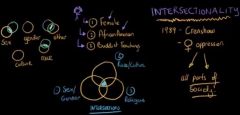
It focuses on the different areas of overlap an individual can experience discrimination to holistically understand the person. |
|
|
What is the social disorganization model of neighborhood safety and crime? |
In places where population density is high, mixed use is allowed (mix of residential w/retail), transient population, worn down infrastructures they are most likely to have higher crime with higher rates of drug addiction, infant mortality, juvenile delinquency high school drops out. Aka social inequality the unequal amounts of resources and depending on the neighborhood, and correspondingly the different levels of mental health risks. |
|
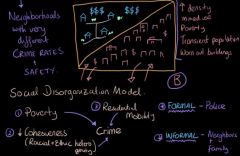
What is the social disorganization model?
|
The social disorganization model states that 3 important environment/residential factors which are high levels of poverty, racial and ethnic heterogeneity, which decreases cohesiveness within that community, high levels of residential mobility (lots of transients) fuel crime not the individual (ethnicity, beliefs, and race)
Ways that crime is managed are by formal factors (e.g. police) and informal factors (e.g. local community/families, neighbors, friends).
In neighborhoods where there is high levels of crime the police force may struggle to contain crime or lack resources and informal factors may often be significantly absent. |
|
|
What is social and racial heterogeneity? |
Many different cultures and groups of different people. |
|
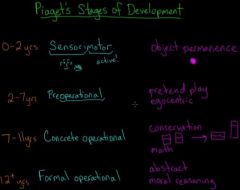
What are Piaget's Stages of Cognitive Development?
|
0-2 yrs - The Sensorimotor |
|
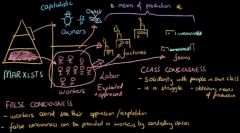
What is class consciousness and false consciousness?
|
It was a theory provided by Karl Marx (Marxist) that says workers (working class) don't realize that they are being exploited and oppressed by a capatalistic model of working where the owners control the means of production and get all the benefits and rewards.
These workers can develop class consciousness in which they realize as a class of society they have solidarity with one another against the owners and must struggle to over come the struggle of oppression and can seize take over ownership.
False consciousness is when they are unable to see oppression/exploitation and the people in power that control the means of production install this false consciousness and promote it within the workers by feeding false information (e.g. giving hope that 1/2 of them can make it out and become owners).
|
|
|
What is racialization? |
The definitions of specific racial and ethnic groups can change over time as the values of a society changes and sometimes racial identities can be ascribed to a minority group |
|
|
What is discimination? |
The unjust treatment of a category of people simply because they belong to that group of people. |
|
|
What is a race? Also, what is racial formation theory? What is ethinicity? |
Race is a social construction that puts people into groups based on observed or perceived differences in physical traits.
Racial formation theory looks at the economic, social, and political factors that result in the socially constructed races (e.g. white, latin american, african-american, asian groups).
Ethnicity is socially defined that groups people based on shared language, history, or nationality.
|
|
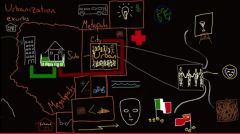
What is Urbanization and what are the basics? What is sub-urbanization?
|
Rural area ( Pop. <2,500) ; Urban (Pop > 1000 sq mile) ; citites (Pop > 50k); Metropolis (Pop > 500K)
Many metropolis = megalopolis (Bost --> DC)
Began during industrialization and people losing jobs at farms due to machines so went to cities to find work and housing. Cities got better do to technology of utilities and job opportunity (more options for everything).
Crowding = feeling of too little space or too many people
Cosopolites = people drawn to the city for culture and conivence(studetsn, artist, entertainers, intellecturs)
singles (jobs, partners, entertainment)
deprived & trapped ( poor, cannot afford to leave the city, elderly)
ethnic villages (people bring native culture when they immigrate)
Suburbanization is when people move to the fringes of the urban areas to have a yard, house, and picket fence (long commute/can turn into an edge city forming independent economic places).
Urban decline (people abandon city)
Excerpts (places beyond the city)
Urban Renewal (renewing old parts of the city can lead to gentrification which targets wealthy and pushes poorer people out of the community)
Rural rebound = people sick of the city and move back out to the rural areas (can afford it)
|
|
|
What are the basics of twin/adoption studies? |
Fraternal twins = 2 different eggs + 2 different sperm not good for twin studies since not same genes
Identical Twins = same egg; splits in 2 = same genes
Seperated twins = controlled genes and environment |
|
|
What is heritability? |
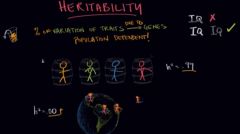
|
|
|
What is secularization?
|
It is the weakening of social and political power of religious organizations, as religious involvement and belief declines. The reaction to secularization is fundamentalism, when people go back to the strict religious teachings and beliefs, though this can create social problems when people become too extreme.
|
|
|
What is a democracy, authoritarian, dictatorship, communism, monarchy systems? |
Democracy is a government that takes into consideration the will of the people.
Authoritarian is an autonomous ruled government.
Dictatorships are authoritarian systems where the government is ruled by an individual w/o the consent of the citizens.
Communism is a classless, money less system, where all property is owned by the community.
A monarchy is a government that is embodied by a single person, where the king and queen are the figurehead. |
|
|
What is capitalism and socialism? |
Capitalism economy is motivated by profits, and features private ownership of production, with a market economy based on supply and demand.
Socialism economy is motivated by what benefits the society as a whole, and features common ownership of production that focuses on human needs and economic demand.
The division of labor in our government and economy is functionalism, meaning everyone is expected to have a responsibility in society. |
|
|
What is functionalism, social facts, and indirect effects? |
Is a system of thinking that looks at society from a large scale perspective and it examines the necessary structures that make up a society and how each part helps keep the society stable. According to functionalism, society (insitutions and people) is headed towards an equilibrium.
Social facts are a way of acting and thinking formed by the society that existed before any one individual and will still exist after an individual is dead, they are unique objects that cannot be influenced by an individual; only noticed when we try to resist them. Examples include laws, moral regulations, religious faiths, and social currents like suicide and birth rate. Suicide of one person has no effect on the presence of suicide in the society, so social facts are a facet of the society itself and are a necessary structure according to Durkheim. Society is dependent on all parts, like a cell to maintain social equilibirum like schools, training people, and business create work for people and a living.
Indirect effects are also called latent functions because they are unrecognized and unintended consequences of institution such as connecting people across societies such as teachers and students forming relationships.
In functionalism, a change to either production, distribution or coordination will force the others to adapt in order to maintain a stable state society. Social change upsets the equilibrium and threatens the mutual interdependence of the people within the society. Functionalism disregards the individual |
|
|
What is conflict theory? |
A way of studying society that focuses on the inequalities of different groups in a society. Based on Karl Maxi, who believed society evolved through several stages, the most important of which were feudalism, capitalism, and finally socialism. In the 19th century Europe was a capitalist society where the rich upper class called the bourgeoisie were a minority of the population. The poor were called the proletariat were the majority. Bourgeoisie owned everything and people only had labor to sell.
Class consiousness would eventually allow them to get the power. |
|
|
What is the social constructionism theory? What are the two threads of social constructionism? |
It is the theory that says knowledge and many aspects of the world around us are not real in and of themselves. They only exist because we give them reality through social agreement. Things like nations, books, even money don't exist in the absence of human society.
The weak social constructionism thread proposes that social constructs are dependent of brute facts, which are the most basic and fundamental and don't rely on any other facts. Brute facts are how voltage goes through the computer screen to make an image, brute facts are what explain quarks and atoms etc. Brute facts are separate from institutional facts which are created by social conventions and do rely on other facts.
Strong social constructionism states that the whole of reality is dependent on language and social habits, that all knowledge is a social construct, and that there are no brute facts. It would say that we created the idea of quarks and everything we use to explain it. There are no facts that just exist.
The main criticism to social constructionism is that it doesn't consider the effect of natural phenomenon on society. And, at least for strong social constructionism, it even has difficulty explaining those phenomena because they don't depend on human speed or action. Strong social constructionism only explains reality through the thoughts of humans. |
|
|
What is symbolic interactionism? |
It is a small scale view of societal interactions that focuses on interactions between individuals, like when you hangout with a friend, instead of large scale structure like education and law. |
|
|
What was Bloomer's 3 tenets explaining symbolic interactionism? |
1st tenet = we act based on the meaning we have given something (e.g. considering a tree as a place to rest so we rest on it)
2nd tenet = we give meaning to things based on our social interactions (e.g. meaning can be different for other people - some people affraid of houses with spiders some don't care - we have different views of something so we act differently).
3rd tenet = the meaning we give something is not permanent and can change to due to everyday life.
|
|
|
What is the rationale-choice theory and what are the 3 assumptions? |
Calculating the likely costs and benefits of any action before deciding what to do is called the rational-choice theory.
1st assumption = Completeness
All actions can be ranked in a complete partial ordering of preference.
Contradictions are that people don't always make rationale decisions that are good for them, choices are limited by class, race gender etc. and choices that benefit others more than themselves contradicts this theory. Also, social norms cause people to act in the best interest of other people (e.g. paying taxes, volunteerting) and that all choices can't be explained
2nd assumption = Transitivity
if action a1 is preferred to a2, and action a2 is preferred toa3, then a1 is preferred to a3. In other words, all actions can be compared with other actions.
3rd assumption = Independence of Irrevelant Alternatives
If A is preferred to B out of the choice set {A,B}, then introducing a third alternative X, thus expanding the choice set to {A,B,X}, must not make B preferable to A.
Taken together, these assumptions imply that given a set of exhaustive and exclusive actions to choose from, an individual can rank the elements of this set in terms of his preferences, this preference structure is internally consistent, and the set has at least one maximal element. |
|
|
What is social exchange theory? |
Social exchange theory proposes that social behavior is the result of an exchange process. The purpose of this exchange is to maximize benefits and minimize costs. According to this theory, people weigh the potential benefits and risks of social relationships. When the risks outweigh the rewards, people will terminate or abandon that relationship. And this makes it seem as if there is a linear relationship, but it isn't. |
|
|
What are the basics of the endocrine system? |
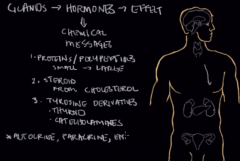
tyrosine derivatives are thyroid hormones T3 (triiodothyronine) & thyroxine (T4) and the catecholamines (dopamine, nore + epi)
autocrine = on itself or same cell next to it
paracrine = same vicinity
endocrine = throughouth the system |
|
|
What are some of the organs of the endocrine system and their hormones? |
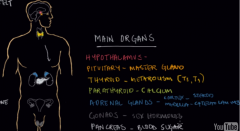
|
|
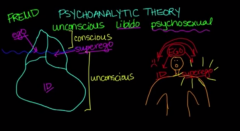
What are the basics of psychoanalytic theory?
|
Within our unconscious our personalities have memories, beliefs, urges, drives, and instinct that we are not always aware of.
Libido is a natural energy source that fuels the mechanisms of the mind and when this libidinal energy is stuck or fixated at various stages of psychosexual development conflicts can occur that have lifelong effects. So fixation at a particular stage is what predicts adult personality.
Freud breaks down mental structures into 3 parts.
Top of the iceberg is our conscious part, the unconscious (large) underneath. The 1st structure is the ID (within unconscious) which develops right after birth and demands immediate gratificaion.
2nd part is the ego, part of con. & uncon., is involved in perceptions, thoughts, and judgments and seeks long-term gratification as opposed to the ID's immediate gratification.
3rd compartment is the superego, which develops at 4 years of age. It is our moral compass or conscience.
Our libidinal impulses want to be gratified and if over-gratified, not gratified, or all or partially gratified, fixation occurs at a psychosexual stage and we face either conflict between the 3 mental structure because all are competing for demand or anxiety.
A freudian slip is an example of a mental conflict. |
|
|
What is social loafing? What is social facilitation? |
When a group collectively works toward a common goal and individuals aren't monitored or evaluated, something called social loafing is likely to occur where people put less effort when working on a group task if the individual contributions aren't evaluated.
Social facilitation is the idea that you will likely do better on a simple task when other people are watching you. However, you would tend to do less well on complex tasks where you were being watched or evaluated. |
|
|
What is the drive reduction theory of motivation? |
It focuses on two main points, drives and needs. The need is a lack or deprivation that is going to energize a drive or an aroused state. That drive is what is going to reduce a need, and that's who we maintain homeostasis or balance. (e.g. trainer says you have to do 50 lunges before you can get H20 - need is water and driven by thirst so drives are typically basic, essential, and physiological.) |
|
|
What this the optimum arousal theory? |
People are motivated to reach full alertness or full arousal. (e.g. people will pay $70 for Disneyland to reach optimum arousal - full alertness, and we like that state). |
|
|
What is Maslow's Hierarchy of Needs? |
It says that we are motivated to satisfy certain needs in a particular order. These needs must be fulfilled from the most basic needs at the bottom all the way to the top. |
|
|
What are the differential association theories of deviance? |

Differential association predicts that an individual will choose the criminal path when the balance of definitions for law-breaking exceeds those for law-abiding. This tendency will be reinforced if social association provides active people in the person's life. The earlier in life an individual comes under the influence high status people within a group, the more likely the individual is to follow in their footsteps. This does not deny that there may be practical motives for crime. If a person is hungry but has no money, there is a temptation to steal. But the use of "needs" and "values" is equivocal. To some extent, both non-criminal and criminal individuals are motivated by the need for money and social gain. |
|
|
What is the labeling theory of deviance? |
Labeling theory takes the view that people become criminals when labeled as such and when they accept the label as a personal identity. Important concepts in labeling theory include primary and secondary deviance, retroactive and prospective labeling, as well as the importance of being stigmatized. Let's examine these concepts and take a look at a few examples.
Under this perspective, people become deviant not because of the act itself, but how people react to that act. As part of this theory there are two types of deviance. Primary deviancerefers to episodes of deviant behavior that many people participate in. Secondary deviance is when someone makes something out of that deviant behavior and is given a negative social label that changes a person's self-concept and social identity. We call this negative label a stigma.
To illustrate this theory, imagine the scenario of two married men away on business trips. Both men have an affair while on this trip, but in only one of the scenarios does the married man get caught, and word gets back to his wife and family back home. He certainly isn't the only married man to have an affair - the fact that he got caught is when secondary deviance sets in - when people start to 'make something' out of his behavior. It is quite possible that the man who got caught will be labeled and will develop a stigma as the result of his behavior. The man who did not get caught (while the act is the same) will not develop the same stigma because his action will go unnoticed. The consequences are not because of the act itself, but because of someone finding out about his behavior and labeling him. |
|
|
What is the strain theory of deviance? |
Sometimes people find that when they attempt to attain culturally approved goals, their paths are blocked. Not everyone has access to institutionalized means, or legitimate ways of achieving success. Strain theory, developed by sociologistRobert Merton, posits that when people are prevented from achieving culturally approved goals through institutional means, they experience strain or frustration that can lead to deviance. He said that they also experience anomie, or feelings of being disconnected from society, which can occur when people do not have access to the institutionalized means to achieve their goals. |
|
|
What is self-concept? What are the 2 aspects of self-concept? |
It is how someone thinks about, perceives or even evaluates themselves.
The 1st aspect is existential self, which is the most basic part of self-concept and it is a sense of being separate and distinct from others, other objects. It is understanding and having awareness that the self is constant. As young as 3 years.
Once the existential self is established then we realize as babies that we exist with other objects and we have properties (e.g. 1st = when kids say they are 3 or 4 yrs old categorize themselves). |
|
|
What is Carl Rogers' view of self-concept? |
He believed the self-concept had 3 different components.
Self-image = the view we have of ourselves
Self-esteem = value we place on ourselves (love).
Ideal Self = what we aspire to be |
|
|
What is the social identity theory? |
It defines the self in two parts, the personal identity (things that are unique to each person - like personality traits) and social identity (groups we belong to). |
|
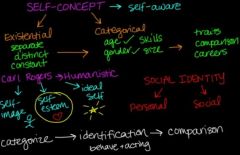
How does the social identity theory evaluate ourselves and others?
|
First, all humans categorize themselves and others w/o knowing it in order to understand objects and identify them.
Second, identification occurs when we adopt the identity of the groups we categorize ourselves within. We start to bind our self-esteem to this group identification and sense of belonging.
Final step, social comparison is where we always compare ourselves to others all the time subconsciously. |
|
|
What are the basics of Freud's psychosexual development theory? |
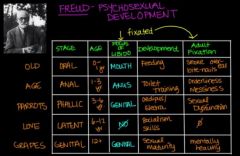
|
|
|
What is Erik Erikson's theory of Psychosocial Development? |
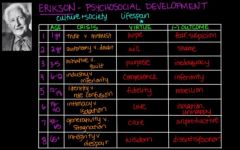
ego psychologist
emphasized the role of culture and society and the conflicts that can take place within the ego itself,
According to Erikson, the ego develops as it successfully resolves crises that are distinctly social in nature. These involve establishing a sense of trust in others, developing a sense of identity in society, and helping the next generation prepare for the future. |
|
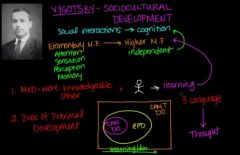
What are the 3 main thoughts of Vygotsky's sociocultural development theory?
|
Higher mental f(x)s are characterized by independent learning and thinking, but can only be cultivated by the elementary mental f(x)s, which involve a tutor or someone older (cooperative & collaborative dialogue) who acts as a guide through which we model our behavior.
MKO (more knowledgeable other), the sociocultural factor which is interacting w/the MKO leads to higher mental f(x)s in independence.
ZPD (zone of proximal development) = the most sensitive instruction or guidance should be given and is defined as the zone in between the ability to be able to do something and not being able to do it. This area allows the learner to develop skills they already hav and use it on their own and go beyond into the areas they can't do, to expand that learning.
Children who engage in large amounts of private speech are actually much more socially competent than children who do not use it that much. So Vygotsky believed that language develops from social interactions for communication purposes and later language ability becomes internalized as thought. So as we become older it becomes more internalized, which is our inner speech so basically thought is a result of language. |
|
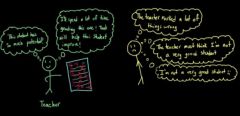
What is Charles Cooley's looking glass self theory? And what 3 steps does this happen in?
|
The view of ourselves come from the direct contemplation of our qualities and how our perceptions of how we are being perceived by others.
1st step = we imagine how we appear to others.
2nd step = how do they evaluate us based on observations of us (funny shy awkward)
3nd step = take information from 2 and 1 and revise how we think of ourselves
Cooley thinks we are not influenced by the opinions of others but influenced by the thought of what we think others think about us. May be wrong or right like the students example with the teacher marking them bad and wanting them to do more, but instead he does less. If the student interacts with the teacher again and explains why she marked bad and what he needs to do he'll try harder and the "revision" will lead to a better self perspective. |
|
|
What is the Just the World Phenomenon? |
It is the assumption that people make that the world is just and that therefore people often get what they deserve, which means that good things happen to good people and bad things happen to bad people. So people of a high social class might try to justify their own position in society by saying that people who are poor must be lazy and if they just worked harder, they might be successful too. So it's easy to see how prejudice but also in discrimination.
Status is relative, in order for people to be of a higher status, by definition there needs to be people of a lower status beneath them. |
|

What are the basics of the Harlow monkey experiment?
|
The Harlow monkeys would rather be with the wire mother with cloth for comfort, referred to as the secure base, than just the wire with the nourishment. The baby knew the mother wasn't going anywhere and could leave to explore and it would be there when it got back so it makes the monkey comfortable enough to explore the world on it's own. |
|
|
What are the 4 types of social support? |
Esteem Support = expressions of confidence and encouragement that people let you know that they believe in you. (coaches, therapists, coaches)
Emotional support = affection, love, trust and caring that involve listening and empathizing, but it can also include physical things like hugs and pats on the back (family, close friends).
Informational Support = Sharing information or giving advice and other kinds of support that can be from family, friends, and from people you don't know WedMD.
Tangible Support / Instrumental Support = financial assistance, material good and services. Basically, taking some of your responsibilities so that you can deal w/other problems. (e.g. banks, volunteers).
Companionship support = gives someone a sense of belonging from many different places (family, friends, romantic partners, co-workers).
It hurt to see my friend parents help them out |
|
|
What is enthnocentricism? |
Evaluating other peoples and cultures according to the standards of one's own culture. |
|
|
What is the fundamental attribution error/correspondence bias/ or attribution effect? |
It is the people's tendency to place an undue emphasis on internal characteristics to explain someone else's behavior in a given situation, rather than considering external factors.
Alice, a driver, is about to pass through an intersection. Her light turns green and she begins to accelerate, but another car drives through the red light and crosses in front of her. The fundamental attribution error may lead her to think that the driver of the other car was an unskilled or reckless driver. This will be an error if the other driver had a good reason for running the light, such as rushing a patient to the hospital. If this is the case and Alice had been driving the other car, she would have understood that the situation called for speed at the cost of safety, but when seeing it from the outside she was inclined to believe that the behavior of the other driver reflected their fundamental nature (having poor driving skills or a reckless attitude). |
|
|
What is modern prejudice? |
Modern prejudice refers to the subtle negative attitudes that are directed toward stigmatized groups such as African-Americans and gay men and lesbian women. Individuals categorized as high in modern prejudice deny the existence of discrimination against stigmatized groups; believe that demands made by these groups are unfair; assert that social institutions accord disproportionate attention to such groups; and reject their efforts to change the status quo. Stated simply, the ethos of an individual high in modern prejudice is: "discrimination is a thing of the past because groups now have all the right they need". |
|
|
What is the social identity theory? |
Social identity is a person’s sense of who they are based on their group membership(s). |
|
|
What is cognitive dissonance? |
Cognitive dissonance asserts that people will feel distress when they hold conflicting attitudes or beliefs, or when the exhibit behavior that is inconsistent with their beliefs. In this question, the grief counselor in (D) is experiencing cognitive dissonance (guilt). He is a grief counselor himself, but chooses not to seek out the help such counselors can provide, which leads to mental distress. |
|
|
What is unintentional side-effect discrimination? |
This is how one institution or organization or sort of sector can influence another negatively. (e.g. economics, politics, law, medicine can all be interdependent and related someway). Unintentional discrimination can arise when an employer sees an applicant is a felon that was unfairly trialed, but doesn't know that and denies him a job. The employer is swayed in an unfair way. |
|
|
What is unintentional past-in-present-discrimination? |
When things were done in the past, even though they may no longer be allowed, can have consequences for people in the present. (e.g. brown v board just after the decision to let blacks integrate into schools the kinds walking through the halls still doesn't feel welcome and mistreated - this is pat-in-present discrimination). |
|
|
What is random mating, assortative mating, and disassortative mating? What is inclusive fitness? |
Random mating = all the individuals in the population or potential partners (ensures genetic diversity).
Assortative mating = similars mate with similars at higher frequency, not random. (e.g. small animals w/small animals, large w/large). Inbreeding can hurt population, because it increases the chance that harmful things will be passed along.
Disassortive mating = individuals w/different or diverse traits mate at a higher frequency.
Inclusive fitness is the # of offspring a person has, how they support them and how offspring support each other. It's evolutionarily advantages to promote the well being of our offspring and our close relatives (highly similar genes). Inclusive fitness makes up for the weakness of selfishness of survival of the fitness since people are kind and nice to each other. |
|
|
What is stereotype threat? |
Stereo type threat is when the exposure to a negative stereotype surrounding a task can actually cause a decrease in the performance of an individual when attempting a task. So here the stereotype actually threatens performance. |
|
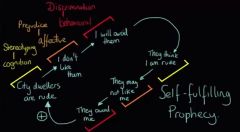
What is the process of moving from stereotyping to prejudice to discrimination? How does this relate to the self-fulfilling prophecy?
|
It is attaching an affect, which is an emotion that can be positive or negative to the our ideas about someone or a group, that are over generalizations, is moving from stereotyping to prejudice. When we act on these thoughts then we move from prejudice to discrimination.
The self-fulfilling prophecy states that the initial thought or cognition, becomes more true and more affirmed over time, either directly or indirectly because our own actions. First by stereotypes then we discriminate and this acts as positive feedback as they act that way back to us. |
|
|
What is Dramaturgy? |
Dramaturgy is the process when people act differently than alone in social settings and want to put forth the best presentation of themselves that they can.
Two parts:
Front Stage = when people manipulate how they are seen in social settings to gain favor with those people and gain some friends - putting on a front and acting for an audience.
Back Stage = private, when the act is over.
Impression management can happen in both front and back stage, with someone doing makeup or changing how they're acting etc. |
|

What Is the Halo Effect?
|
The halo effect is a type ofcognitive bias in which our overall impression of a person influences how we feel and think about his or her character. Essentially, your overall impression of a person ("He is nice!") impacts your evaluations of that person's specific traits ("He is also smart!").
One great example of the halo effect in action is our overall impression of celebrities. Since we perceive them as attractive, successful, and often likeable, we also tend to see them as intelligent, kind, and funny. Halo boost. If we find their first impression is best then we may think their other qualities are better and give them a halo boost. |
|
|
What is Kohlbergs theory of moral development? |
It is a based on cognitive development, that looked at how people developed their morals vs their overall development (emotional, physical development throughout life). Or how people's morals changed as they grew.
People must go through a series of stages and each successive one replaces the earlier (ladder of morality).
A - Premoral stage =
1. Obedience vs punishment = Here authority is outside the individual and reasoning based on physical consequences of action (fixed and absolute). So if good they will avoid being punished.
2. Individualism and Exchange = begin to realize there is not just one right view that is handed down by the authorities (different individuals have different viewpoints).
B - Conventional Stage =
3. Good Boy + Good Girl - authority is internalized, but not questioned, and reasoning is based on the norm o the group to which the person belongs (all about good boy and good girl). Now they're taking into account other people's views so are being good to seem good to other people (conformity).
4. Law + Order - child becomes aware of the wider rules of society and obey them in order to feel guilty. So it's all about what society says here.
C - Post-Conventional Stage - individual judgement is based on self-chose principles. Higher level reasoning.
5. Social Contract - Even though rules and laws exist for the good of the greater # of people, there are times that this law in order still may work against the interest of particular people. The protection of life is more important then breaking the law and stealing which is level 4.
6. Universal Ethical Principle - People develop their own set of moral guidelines which may or may not fit the law. Very few people reach this stage when principles apply to everyone such as human rights, justice, and equality and a person who upholds these wholeheartedly and will act to defend them are here even if they risk punishment. |
|
|
What are the primacy and recency social perceptions? |
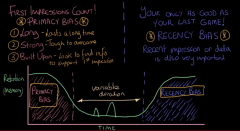
|
|
|
What is the attribution theory and covariation theory?? |
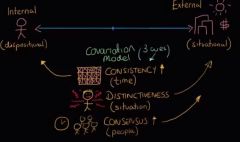
We explain people's behaviors and ours based on internal (dispositional) or external (situational) factors. How we find explanation for the behaviors of others. Behavior is on a spectrum since combination of the 2 factors.
Within the covariation model: If consistency of behavior is high we attribute it to interanal (dispositional). Distinctiveness of the situation may lead to odd behaviors or normal. Consensus (people) behavior is due to the environment of external (situational). |
|

How do cultures attribute error and what is the self-serving bias?
|
Self-serving bias = people protect or enhance their self-esteem by attributing successive to ourselves and failures to the environment. More common in individualistic cultures.
|
|
|
What is Fundamental Attribution Error (correspondence bias) and what is the Actor-Observer Bias? |
FAE = attributing behaviors to internal factors (e.g. they are fat because who they are) under-recognizing external factors.
We are more likely to blame things on external factors for our own behaviors (victims of circumstance) and attribute others behaviors to internal factors and this is the Actor-Observer bias in which people tend to overemphasize the role of a situation in their behaviors and underemphasize the role of their own personalities. |
|
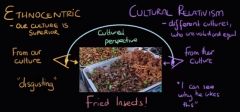
What is ethnocentricism and cultural relativism?
|
Ethnocentricism = judging others' cultural behaviors based on our own and seeing ours as superior.
Cultural Relativism = Looking at a culture from other cultures perspectives. Not good or bad, just equal. |
|
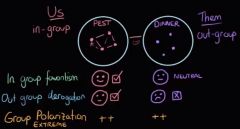
What are in-groups and out-groups? And what is in-group favoritism? What is out-group derogation? What is group polarization?
|
The group we are in or part of or psychologically most connected with is in group. We tend to demonstrate stronger interactions w/people in that group than the out-group and are more common and influential interactions.
In-group favoritism = can occur with people in the out-group we are neutral towards.
Out-group Derogation = super friendly towards in-group and mean to out-group if we feel they are undermining our group.
Group Polarization = the group makes decisions that are more extreme than what initial individual members wanted. |
|

What are the basics of stigmas?
|
Social stigma is the extreme disapproval of (or discontent with) a person or group on socially characteristic grounds that are perceived, and serve to distinguish them, from other members of a society. Stigma may then be affixed to such a person, by the greater society, who differs from their cultural norms. |
|
|
What is anomie?
|
It is the breakdown of social bonds between an individual and the community
|
|
|
What is social stratification? What is social mobility? What is intragenerational mobility and intergenerational?
|
Social stratification = system by which society ranks categories of people in a hierarchy more specifically addresses the class-based hierarchy not demographics
Social Mobility = a change in position within the social hierarchy Intragenerational Mobility = change in social position that occurs during a person's lifetime Intergenerational Mobility = change in social position that occurs over multiple generations |
|
|
What is social reproduction?
|
This is the structures and activities that transmit social inequality from one generation to the next. There are 4 types of capital that contribute.
Financial capital = income and wealth Cultural Capital = shared outlook, beliefs, knowledge, and skills that are passed between generation Human Capital (influenced by cultural capital) = education and job training a person receives/ human capital creates the ability for one to attain social capital, which is essentially the social network one belongs to. All 4 play a role in social reproduction because capital is passed from generation to generation and keeps people in the same social class as their parents before them. This keep reproducing inequality through the system of social stratification. Refers to the perpetuation of inequalities through social institutions ( such as education or the economy). |
|
|
What is relative poverty?
|
Relative poverty refers to a standard which is defined in terms of the society in which an individual lives and which therefore differs between countries and over time. An income-related example would be living on less than X% of average UK income.
Absolute poverty refers to a set standard which is the same in all countries and which does not change over time. An income-related example would be living on less than $X per day. |
|
|
What is institutional discrimination?
|
Discrimination referes to treatment stemming from institutional culture or policies (rather than individual action).
|
|
|
What is cultural relativism?
|
The evaluation of another culture based on that culture's standards.
|

